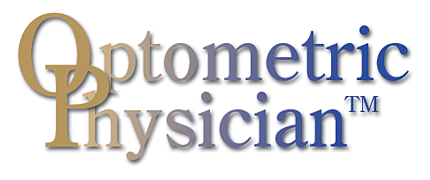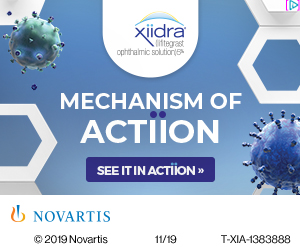
A
weekly e-journal by Art Epstein, OD, FAAO
Off the Cuff: Some Secret Sauce
One of the basic tenets of medicine is sharing knowledge freely. It is a principle I hold dear and a large part of the reason for the existence of Optometric Physician. Over the past year, I’ve made some huge advances in understanding and treating dry eye. In this issue, I’ll share some of what I’ve figured out—what some call my “secret sauce.” Hopefully you will find it helpful. Note that some of it is off-label; also, I have no financial interest in any of the products mentioned.
|
|||||
 |
||
| The Distribution of Retinal Venous Pressure and Intraocular Pressure Differs Significantly in Patients with Primary Open-angle Glaucoma | ||||
Until now, venous pressure within the eye has widely been equated with intraocular pressure (IOP). Measurements with dynamometers calibrated in instrument units or in force showed that the retinal venous pressure (RVP) may be higher than the IOP in glaucoma patients. In this study, the RVP was measured with a contact lens dynamometer calibrated in mmHg. Fifty consecutive patients ages 69 ± 8 years with primary open-angle glaucoma (POAG) who underwent diurnal curve measurement under medication were included. RVP was measured via contact lens dynamometry, and IOP measurement was measured via dynamic contour tonometry. In all 50 patients, the IOP was 15.9 mmHg [median (Q1; Q3)] (13.6 mmHg; 17.1 mmHg), and the RVP was 17.4 mmHg (14.8 mmHg; 27.2 mmHg). The distribution of the IOP was normal, and that of the RVP was right skewed. In the subgroup of 34 patients with spontaneous pulsation of the central retinal vein (SVP), the IOP and therefore, by definition, the RVP was 16.5 mmHg (13.7 mmHg; 17.4 mmHg). In the subgroup of 16 patients without SVP, the IOP was 14.8 mmHg (13.3 mmHg; 16.4 mmHg), and the RVP was 31.3 mmHg (26.2 mmHg; 38.8 mmHg). In systemic treatment, the number of patients for the prescribed drugs were: ACE inhibitors (20), β-blockers (17), angiotensin II-receptor blockers (13), calcium channel blockers (12), diuretics (7). No difference in RVP was observed between patients receiving these drugs and not receiving them, except in the β-blocker group. Here, the 17 patients with systemic β-blockers had a median RVP of 15.6 mmHg and 20.2 mmHg without. In the 16 patients with a higher RVP than IOP, only one patient received a systemic β-blocker. The median IOP was 15.7 mmHg with systemic β-blockers and 16.1 mmHg without. |
||||
SOURCE: Stodtmeister R, Koch W, Georgii S, et al. The distribution of retinal venous pressure and intraocular pressure differs significantly in patients with primary open-angle glaucoma. Klin Monbl Augenheilkd. 2021; Jan 12. [Epub ahead of print]. |
||||
 |
||
| Clinical Effectiveness of Laser-induced Increased Depth of Field for the Simultaneous Correction of Hyperopia and Presbyopia | ||||
These researchers evaluated the visual outcomes of patients with presbyopic hyperopia, comparing the current standard of monovision treatment with a novel bilateral presbyopic LASIK (Custom-Q mode) technique. This prospective comparative study of consecutive eligible patients with presbyopic hyperopia undergoing a bilateral presbyopic laser in situ keratomileusis technique was conducted between January 2018 and February 2019. After contact lens-simulated monovision measurements were obtained, the non-dominant eyes had a negative aspheric ablation profile planned using the Custom-Q nomogram (Alcon Laboratories). The dominant eye was operated on with a positive aspheric ablation profile. Visual acuity testing, refraction, corneal asphericity (▵Q), higher order aberrations and a satisfaction questionnaire (National Eye Institute Refractive Error Quality of Life) were evaluated after the monovision trial and postoperatively.
|
||||
| SOURCE: Rahmania N, Salah I, Rampat R, et al. Clinical effectiveness of laser-induced increased depth of field for the simultaneous correction of hyperopia and presbyopia. J Refract Surg. 2021; Jan 1;37(1):16-24. [Epub ahead of print]. | ||||
| Depression Among Keratoconus Patients | ||||
Depression is a highly prevalent disorder globally and locally in Saudi Arabia. Individuals with chronic conditions are more liable to develop depression. Keratoconus is a chronic progressive corneal disorder that markedly affects the vision and quality of life, making its sufferers liable to developing depression. This was a descriptive cross-sectional study that was conducted using 9-item Patient Health Questionnaire (PHQ-9) to screen for depression among adults ages 18 to 60 years old only. The participants in this study were patients who were previously diagnosed with keratoconus by their ophthalmologists. The structured questionnaire was distributed using Google Forms through various social media platforms. After extracting the data, it was revised, coded and then analyzed using the Statistical Packages for Social Sciences (SPSS), version 21 (IBM Corp.). A total of 330 keratoconus patients living in Saudi Arabia were recruited in this study. The modal age group was 31 to 40 years old (44.5%), and the male to female ratio was 3:2. The most frequently reported concurrent eye diseases of the patients were astigmatism (48.5%) and myopia (36.7%). The prevalence of depression among patients with keratoconus was 40.6% (n=134). The use of corrective contact lenses (both: hybrid and rigid lens) in both eyes contributed to a significantly higher depression rate among its wearers compared to users in one eye and non-users. |
||||
| SOURCE: Al-Dairi W, Al Sowayigh OM, Al Saeed AA, et al. Depression among keratoconus patients in Saudi Arabia. Cureus. 2020; Dec 6;12(12):e11932. | ||||
| News & Notes | ||||||||
Haag-Streit Introduces Lenstar Myopia
|
||||||||
| Eye Health Organizations Unveil New Recommendations for Myopia Johnson & Johnson Vision announced a new guide with recommendations for eye care professionals to assess, monitor and treat myopia in children. “Managing Myopia: A Clinical Response to the Growing Epidemic,” is the result of a year of collaboration with the American Optometric Association, American Academy of Optometry, Association of Schools and Colleges of Optometry, and Singapore Optometric Association. This marks the latest milestone to address the growing myopia epidemic following the establishment of a strategic research partnership between Johnson & Johnson Vision, the Singapore National Eye Centre and the Singapore Eye Research Institute. Learn more. |
||||||||
|
||||||||
|
||||||||
|
Optometric Physician™ (OP) newsletter is owned and published by Dr. Arthur Epstein. It is distributed by the Review Group, a Division of Jobson Medical Information LLC (JMI), 19 Campus Boulevard, Newtown Square, PA 19073. HOW TO ADVERTISE |



